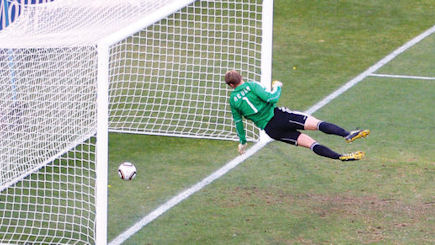This article first appeared in the Jan/Feb 2015 issue of World Gaming magazine.
Some might have considered it fate that technology would play such a major role in the outcome when Chelsea traveled to Liverpool early in the 2014/15 season. The two English giants share a level of animosity between them due to several controversial incidents over the years, among the most memorable being Luis Garcia’s so-called “ghost goal” in their 2005 Champions League semi-finals which ultimately sent Liverpool through to the final. But in their most recent encounter the referee’s blushes were saved as Blues defender Gary Cahill’s close range shot was initially waved away only to be awarded a goal moments later. Have football’s authorities finally seen the light?

Luis Garcia scores the ‘ghost goal’ that put Liverpool through to the 2005 Champions League final
It would be fascinating to see how different football’s history would be had goal-line technology been introduced back in 2005, or even earlier. To this day there is still no effective video image showing whether Luis Garcia’s goal crossed the line or not, so without black and white evidence this story will remain a memorable part of football history alongside Geoff Hurst’s famous “Wembley Goal” – since proved to have never crossed the line – which handed England a 3-2 win over West Germany in the 1966 World Cup final.
Often referred to as “phantom goals”, it was Chelsea manager Josè Mourinho who coined the phrase “ghost goal” in reference to Garcia’s effort and sarcastically joked that Anfield’s famous Kop “sucked” the ball into the net. In fact, the roar of “goal” from the home fans was indeed deafening and may well have influenced the referee. But with the goal-line technology being used these days, it might have been a different story. Ironically, the use of technology in the development of the football itself played its part in compounding the problem in the first place, with the lighter balls in play today a lot tougher to follow given they travel faster and with much greater swerve.
For many years, the powers that be remained strangely resistant to the introduction of technology but the 2014 World Cup in Brazil proved to be a breakthrough tournament for the historically conservative FIFA. Of course, it took another disastrous error at the 2010 World Cup to finally convince them. In the first round of the knockout stages, England trailed Germany 2-1 on the stroke of half-time when Frank Lampard fired a shot that struck the underside of the crossbar and bounced almost a metre over the goal line. Incredibly, referee Jorge Larrionda waved play on and a deflated England went on to lose 4-1.
FIFA has long questioned the reliability of goal-line technology, but that hasn’t stopped other sports such as cricket, tennis and American football using similar systems despite their requirements being far more complicated. Thankfully, the Lampard gaffe was too embarrassing to ignore.
Finally introduced in Brazil, France became the first team in World Cup history to benefit from goal-line technology in their second group game against Honduras when Karim Benzema’s second half strike trickled over the line.

Tennis has successfully employed hawk-eye technology for a number of years now
Now English Premier League fans are enjoying 3D images showing a range of different angles whenever these close calls occur, while the pressure has been released from referees who are now informed definitively whether the ball crossed the line. In Gary Cahill’s case against Liverpool, it all happened so fast that even a number of his Chelsea teammates didn’t realize he had scored before technology proved otherwise
Touted as the best league in the world – and certainly the most widely viewed – it’s no surprise that the TV networks were using technology to great effect long before FIFA and friends clued into the benefits of getting things right. Sky TV has been showing games in 3D for some time now, while their standard HD live broadcast is second to none. ESPN uses 3D projection mapping technology in their half time and post-match analysis, while the same technology is now used regularly in BBC’s Match of the Day program.
On the pitch, goal-line technology is not the only thing the EPL has “borrowed” from the World Cup this season. The popular vanishing foam called Aero Comex Futline, first created by a Brazilian inventor 10 years ago, has become a very handy tool for EPL referees. The foam is sprayed on the ground when a free kick is given to provide an exact mark for the ball to be placed. A line is also drawn 10 yards away behind which the defensive wall must stand, thus preventing defenders from creeping forward while the referee isn’t watching. And of course, as its “vanishing foam” moniker suggests, the foam dissipates within a minute or two, leaving no trace!

Frank Lampard’s strike for England at the 2010 World Cup was ruled no goal by the referee despite video replays showing the ball clearly crossed the line
Technology is changing football in a number of different ways. Leading manufacturers such as Nike and Adidas are constantly trying to improve the look, feel and performance of their products with jerseys that are more comfortable and sweat resistant, plus balls and boots that are lighter. Club scouts have access to special Apps with huge databases to help them keep up with leagues and players around the world; training and fitness staff use heart rate monitors and GPS trackers during games to evaluate player performance; and healthier diet plans along with functional therapies are used precisely to help prolong players’ careers.
But is it enough? There are still a number of gray areas in matches where technology is yet to be used – and Cahill’s goal against Liverpool is the perfect example. While video clearly showed the ball crossing the line, it also showed that Nemanja Matić was offside when he chested the ball back towards Cahill’s feet. Replays also showed a clear handball by Cahill late in the game that should have handed Liverpool a penalty. The number of goals incorrectly ruled in or out due to the absence of goal-line technology in the past is miniscule compared to mistaken offside and penalty rulings, but as of now there have been no moves to use technology to get these decisions right.
We can only hope that the success of goal-line technology and vanishing foam in recent times eventually convinces FIFA and the big leagues around the world that technology is the way of the future.







